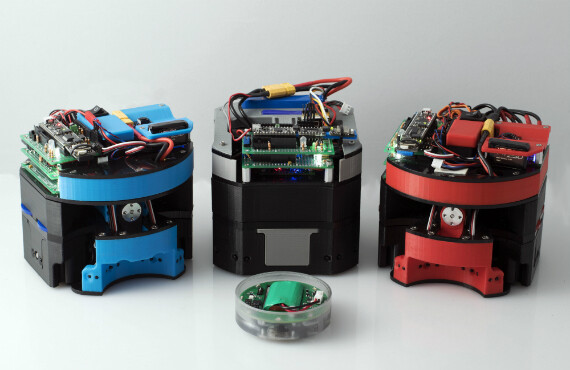Penn Engineers Put Their Skills and Teamwork to the Test in a Robotic Hockey Tournament
By Madeleine Stone @themadstone
While final exams can be solemn affairs, finals for the Design of Mechatronic Systems course at the University of Pennsylvania couldn’t be livelier.
The Robockey Cup, brainchild of Jonathan Fiene, the director of laboratory programs in the Department of Mechanical Engineering and Applied Mechanics, is the culmination of five weeks spent designing, coding and building a team of fully autonomous robots to compete in a game of hockey.
Students, along with a packed room of spectators, cheered and celebrated as their teams, two pint-sized players and a goalie, skate around a miniature rink on wheels, hunt for the puck using motion sensors, taken from Wii remotes, and score on their opponents by shooting with pistons.
“Professor Fiene encourages us to just take this competition and run with it,” says Foster Collins, a junior majoring in mechanical engineering and applied mechanics. “Everyone has so much fun, it sorta just takes over your life.”
Robockey challenges students to synthetize knowledge from mechanical and electrical engineering and computer science and to overcome complex design hurdles in a time crunch. This year’s winning team included four first-year MEAM master’s students, Xiaozhuo Cheng, Xuming Mo, Yifan Yang and Xiaojun Sun.
MEAM undergraduates, juniors Collins and Aedhan Loomis, and seniors Mark Gallagher and Christopher Li, comprised the runner-up team.
Cheng, Mo, Sun and Yang became fast friends at Penn, all having grown up and completed their undergraduate degrees in mechanical engineering or a related field in China. While friendship brought this team together, the group’s diverse skill sets became its greatest asset.
“We had communicated over some individual projects before Robockey, and we knew that each of us had different knowledge in electronics and coding, different advantages they could bring to the team,” says Mo.
Collins’s team also brought a range of skills to the table, including expertise in coding and mechanical design. Early on, both teams saw merit in dividing and conquering the tasks involved in constructing their robots.
“We split up tasks based on personal interests,” says Yang. “I haven’t had much experience coding before, so I decided this would be a good opportunity to get some practice.”
Collins took on the bulk of his team’s coding, writing a library of scripts to run the motor drivers, while Loomis quickly began developing prototype bots.
“There are a ton of different aspects to this project,” Collins says. “You really have to hit the ground running and use your time efficiently.”
Both teams worked down to the wire get their bots in tip-top shape for competition. In the days leading up to the tournament, Mo’s team faced a frustrating challenge: Following a turn, one of their robot’s wheels would start spinning faster than the other, causing the robot to wobble and swerve.
Cheng scoured the Penn library, digging up papers on theoretical mechanics that might shed light on this problem. Mere hours before the tournament, the team finished coding a control mechanism that corrected for the speed difference between the two wheels, allowing the robot to drive straight.
“We all discussed the problem, and got great new ideas about robot control,” says Mo. “Though Robockey is a hands-on job, it was great that we could combine deep theoretical understanding with the practical aspects.”
Collins’ team also had to overcome design challenges. Watching matches from previous years, the team noticed that, when the hockey puck hit a sidewall, robots had difficulty pushing it back toward the center of the arena.
“We realized that if you could get your wheels parallel to the wall and still hold the puck, you’d end up with a much better force vector on the puck,” says Collins.
Inspired by this observation, the team built an articulated front piece that could rotate a puck towards the wall to encapsulate it in a firmer grip. Unfortunately, the novel feature broke several times during testing, and 48 hours out from the competition the team made the tough call to scrap it.
“We realized that there were more important features and code to work on that would benefit us more than the articulation would. It’s a bummer to cut out functionality, but I think the simple solution was the right call in the end,” says Collins.
“From initial meetings to making the final robots, we were able to work together to resolve design challenges and knew that we could rely on other teammates to put time in to finish things on the tight time frame,” Loomis added.
Only half of the 24 teams that took up the Robockey challenge competed in the final tournament. Everyone, however, showed up to cheer on the finalists. The tournament also drew a score of Robockey alumni and members of the broader Penn community.
“Robockey is really more than a tournament,” says Mo. “Everyone who chose this course became a family. We all celebrated for each other, no matter how far we got.”
The event was also broadcast online, allowing team members’ families to watch from across the world.
“All of our families were watching from China,” says Mo. “For me, it was amazing that my parents and grandparents, thousands of miles away, were able to be there. For them to be able to see what I’ve been achieving at Penn and share in our happiness when we won the tournament was really special.”








